Economics of Tobacco: Excise Duty, Demand, and Company Strategy
VerifiedAdded on 2023/01/12
|10
|2450
|36
Essay
AI Summary
This essay delves into the economic fundamentals of tobacco excise duty, examining its advantages for governments, justifications for its implementation, and the determinants of price elasticity of demand for tobacco products. The analysis includes a case study focusing on the UK tobacco market, exploring the impact of taxation on consumer behavior, particularly the price sensitivity of poor smokers. Furthermore, the essay calculates the price elasticity of demand and proposes a long-term strategy for a global tobacco company in response to potential increases in excise duty. The essay concludes with a comprehensive overview of the economic principles at play, offering insights into the complexities of tobacco taxation and its effects on both consumers and the industry.

Fundamentals of economics
Paraphrase This Document
Need a fresh take? Get an instant paraphrase of this document with our AI Paraphraser

Contents
INTRODUCTION...........................................................................................................................1
MAIN BODY..................................................................................................................................1
Advantages of increase in tobacco excise duty tax for the government......................................1
Justification for governments to levy extra taxes on tobacco......................................................2
Determinants of the price elasticity of demand for tobacco products and reasons for why poor
smokers are more price sensitive than the rich............................................................................3
Calculating the price elasticity of demand...................................................................................4
Long-term strategy for global tobacco company if the UK government announces it has plans
for year on year real increases in excise duty on tobacco products.............................................5
CONCLUSION................................................................................................................................5
REFERENCES................................................................................................................................6
INTRODUCTION...........................................................................................................................1
MAIN BODY..................................................................................................................................1
Advantages of increase in tobacco excise duty tax for the government......................................1
Justification for governments to levy extra taxes on tobacco......................................................2
Determinants of the price elasticity of demand for tobacco products and reasons for why poor
smokers are more price sensitive than the rich............................................................................3
Calculating the price elasticity of demand...................................................................................4
Long-term strategy for global tobacco company if the UK government announces it has plans
for year on year real increases in excise duty on tobacco products.............................................5
CONCLUSION................................................................................................................................5
REFERENCES................................................................................................................................6

⊘ This is a preview!⊘
Do you want full access?
Subscribe today to unlock all pages.

Trusted by 1+ million students worldwide
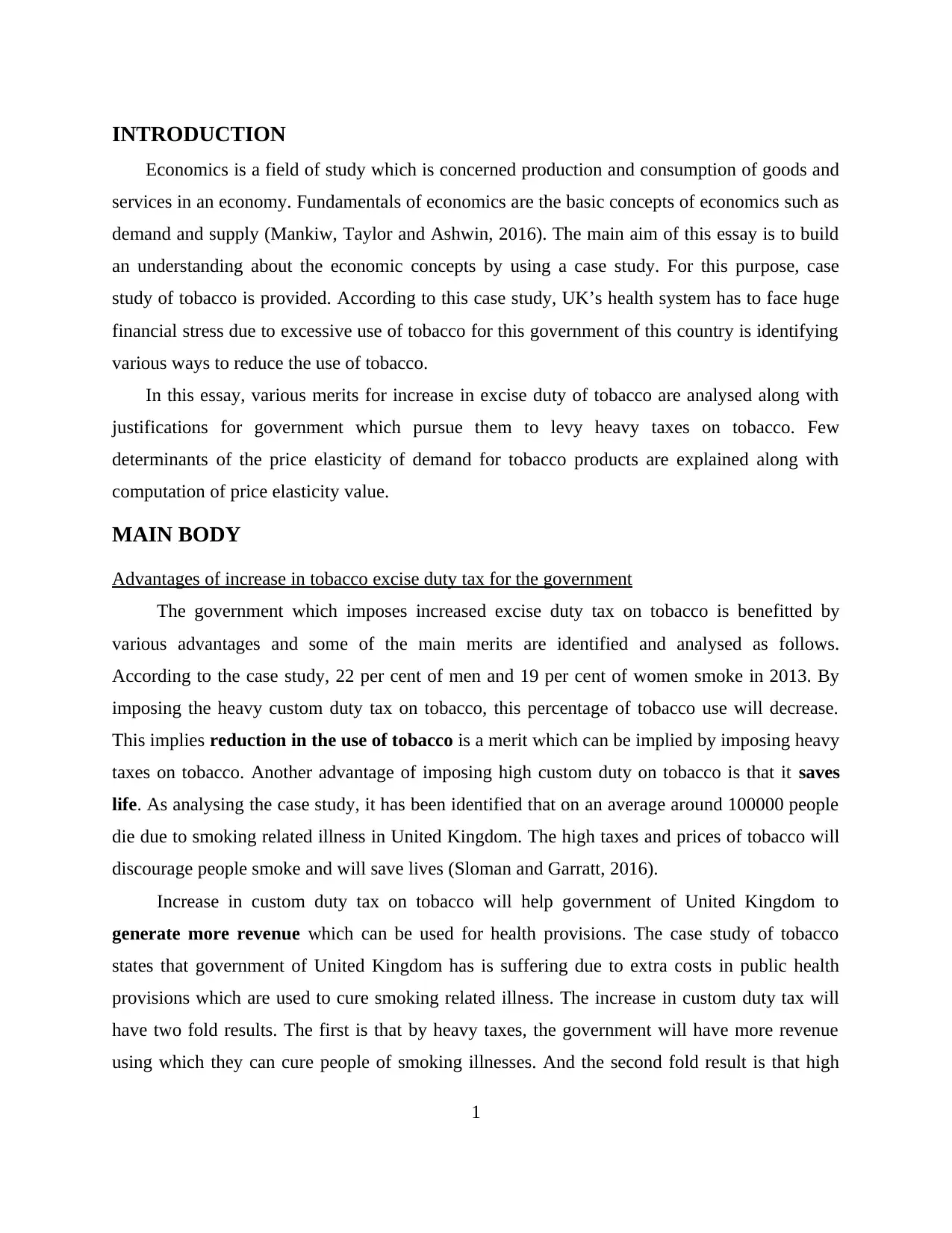
INTRODUCTION
Economics is a field of study which is concerned production and consumption of goods and
services in an economy. Fundamentals of economics are the basic concepts of economics such as
demand and supply (Mankiw, Taylor and Ashwin, 2016). The main aim of this essay is to build
an understanding about the economic concepts by using a case study. For this purpose, case
study of tobacco is provided. According to this case study, UK’s health system has to face huge
financial stress due to excessive use of tobacco for this government of this country is identifying
various ways to reduce the use of tobacco.
In this essay, various merits for increase in excise duty of tobacco are analysed along with
justifications for government which pursue them to levy heavy taxes on tobacco. Few
determinants of the price elasticity of demand for tobacco products are explained along with
computation of price elasticity value.
MAIN BODY
Advantages of increase in tobacco excise duty tax for the government
The government which imposes increased excise duty tax on tobacco is benefitted by
various advantages and some of the main merits are identified and analysed as follows.
According to the case study, 22 per cent of men and 19 per cent of women smoke in 2013. By
imposing the heavy custom duty tax on tobacco, this percentage of tobacco use will decrease.
This implies reduction in the use of tobacco is a merit which can be implied by imposing heavy
taxes on tobacco. Another advantage of imposing high custom duty on tobacco is that it saves
life. As analysing the case study, it has been identified that on an average around 100000 people
die due to smoking related illness in United Kingdom. The high taxes and prices of tobacco will
discourage people smoke and will save lives (Sloman and Garratt, 2016).
Increase in custom duty tax on tobacco will help government of United Kingdom to
generate more revenue which can be used for health provisions. The case study of tobacco
states that government of United Kingdom has is suffering due to extra costs in public health
provisions which are used to cure smoking related illness. The increase in custom duty tax will
have two fold results. The first is that by heavy taxes, the government will have more revenue
using which they can cure people of smoking illnesses. And the second fold result is that high
1
Economics is a field of study which is concerned production and consumption of goods and
services in an economy. Fundamentals of economics are the basic concepts of economics such as
demand and supply (Mankiw, Taylor and Ashwin, 2016). The main aim of this essay is to build
an understanding about the economic concepts by using a case study. For this purpose, case
study of tobacco is provided. According to this case study, UK’s health system has to face huge
financial stress due to excessive use of tobacco for this government of this country is identifying
various ways to reduce the use of tobacco.
In this essay, various merits for increase in excise duty of tobacco are analysed along with
justifications for government which pursue them to levy heavy taxes on tobacco. Few
determinants of the price elasticity of demand for tobacco products are explained along with
computation of price elasticity value.
MAIN BODY
Advantages of increase in tobacco excise duty tax for the government
The government which imposes increased excise duty tax on tobacco is benefitted by
various advantages and some of the main merits are identified and analysed as follows.
According to the case study, 22 per cent of men and 19 per cent of women smoke in 2013. By
imposing the heavy custom duty tax on tobacco, this percentage of tobacco use will decrease.
This implies reduction in the use of tobacco is a merit which can be implied by imposing heavy
taxes on tobacco. Another advantage of imposing high custom duty on tobacco is that it saves
life. As analysing the case study, it has been identified that on an average around 100000 people
die due to smoking related illness in United Kingdom. The high taxes and prices of tobacco will
discourage people smoke and will save lives (Sloman and Garratt, 2016).
Increase in custom duty tax on tobacco will help government of United Kingdom to
generate more revenue which can be used for health provisions. The case study of tobacco
states that government of United Kingdom has is suffering due to extra costs in public health
provisions which are used to cure smoking related illness. The increase in custom duty tax will
have two fold results. The first is that by heavy taxes, the government will have more revenue
using which they can cure people of smoking illnesses. And the second fold result is that high
1
Paraphrase This Document
Need a fresh take? Get an instant paraphrase of this document with our AI Paraphraser
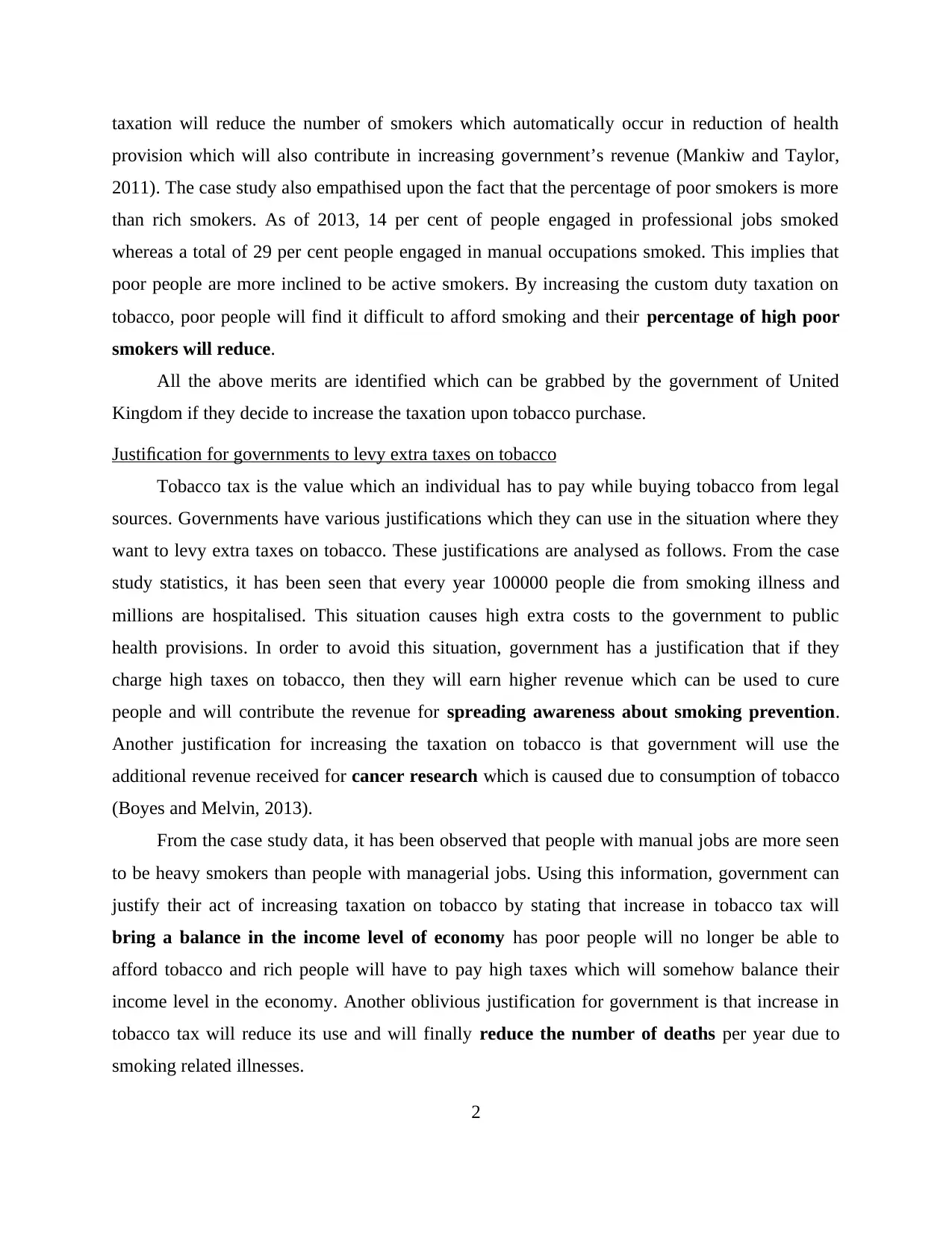
taxation will reduce the number of smokers which automatically occur in reduction of health
provision which will also contribute in increasing government’s revenue (Mankiw and Taylor,
2011). The case study also empathised upon the fact that the percentage of poor smokers is more
than rich smokers. As of 2013, 14 per cent of people engaged in professional jobs smoked
whereas a total of 29 per cent people engaged in manual occupations smoked. This implies that
poor people are more inclined to be active smokers. By increasing the custom duty taxation on
tobacco, poor people will find it difficult to afford smoking and their percentage of high poor
smokers will reduce.
All the above merits are identified which can be grabbed by the government of United
Kingdom if they decide to increase the taxation upon tobacco purchase.
Justification for governments to levy extra taxes on tobacco
Tobacco tax is the value which an individual has to pay while buying tobacco from legal
sources. Governments have various justifications which they can use in the situation where they
want to levy extra taxes on tobacco. These justifications are analysed as follows. From the case
study statistics, it has been seen that every year 100000 people die from smoking illness and
millions are hospitalised. This situation causes high extra costs to the government to public
health provisions. In order to avoid this situation, government has a justification that if they
charge high taxes on tobacco, then they will earn higher revenue which can be used to cure
people and will contribute the revenue for spreading awareness about smoking prevention.
Another justification for increasing the taxation on tobacco is that government will use the
additional revenue received for cancer research which is caused due to consumption of tobacco
(Boyes and Melvin, 2013).
From the case study data, it has been observed that people with manual jobs are more seen
to be heavy smokers than people with managerial jobs. Using this information, government can
justify their act of increasing taxation on tobacco by stating that increase in tobacco tax will
bring a balance in the income level of economy has poor people will no longer be able to
afford tobacco and rich people will have to pay high taxes which will somehow balance their
income level in the economy. Another oblivious justification for government is that increase in
tobacco tax will reduce its use and will finally reduce the number of deaths per year due to
smoking related illnesses.
2
provision which will also contribute in increasing government’s revenue (Mankiw and Taylor,
2011). The case study also empathised upon the fact that the percentage of poor smokers is more
than rich smokers. As of 2013, 14 per cent of people engaged in professional jobs smoked
whereas a total of 29 per cent people engaged in manual occupations smoked. This implies that
poor people are more inclined to be active smokers. By increasing the custom duty taxation on
tobacco, poor people will find it difficult to afford smoking and their percentage of high poor
smokers will reduce.
All the above merits are identified which can be grabbed by the government of United
Kingdom if they decide to increase the taxation upon tobacco purchase.
Justification for governments to levy extra taxes on tobacco
Tobacco tax is the value which an individual has to pay while buying tobacco from legal
sources. Governments have various justifications which they can use in the situation where they
want to levy extra taxes on tobacco. These justifications are analysed as follows. From the case
study statistics, it has been seen that every year 100000 people die from smoking illness and
millions are hospitalised. This situation causes high extra costs to the government to public
health provisions. In order to avoid this situation, government has a justification that if they
charge high taxes on tobacco, then they will earn higher revenue which can be used to cure
people and will contribute the revenue for spreading awareness about smoking prevention.
Another justification for increasing the taxation on tobacco is that government will use the
additional revenue received for cancer research which is caused due to consumption of tobacco
(Boyes and Melvin, 2013).
From the case study data, it has been observed that people with manual jobs are more seen
to be heavy smokers than people with managerial jobs. Using this information, government can
justify their act of increasing taxation on tobacco by stating that increase in tobacco tax will
bring a balance in the income level of economy has poor people will no longer be able to
afford tobacco and rich people will have to pay high taxes which will somehow balance their
income level in the economy. Another oblivious justification for government is that increase in
tobacco tax will reduce its use and will finally reduce the number of deaths per year due to
smoking related illnesses.
2
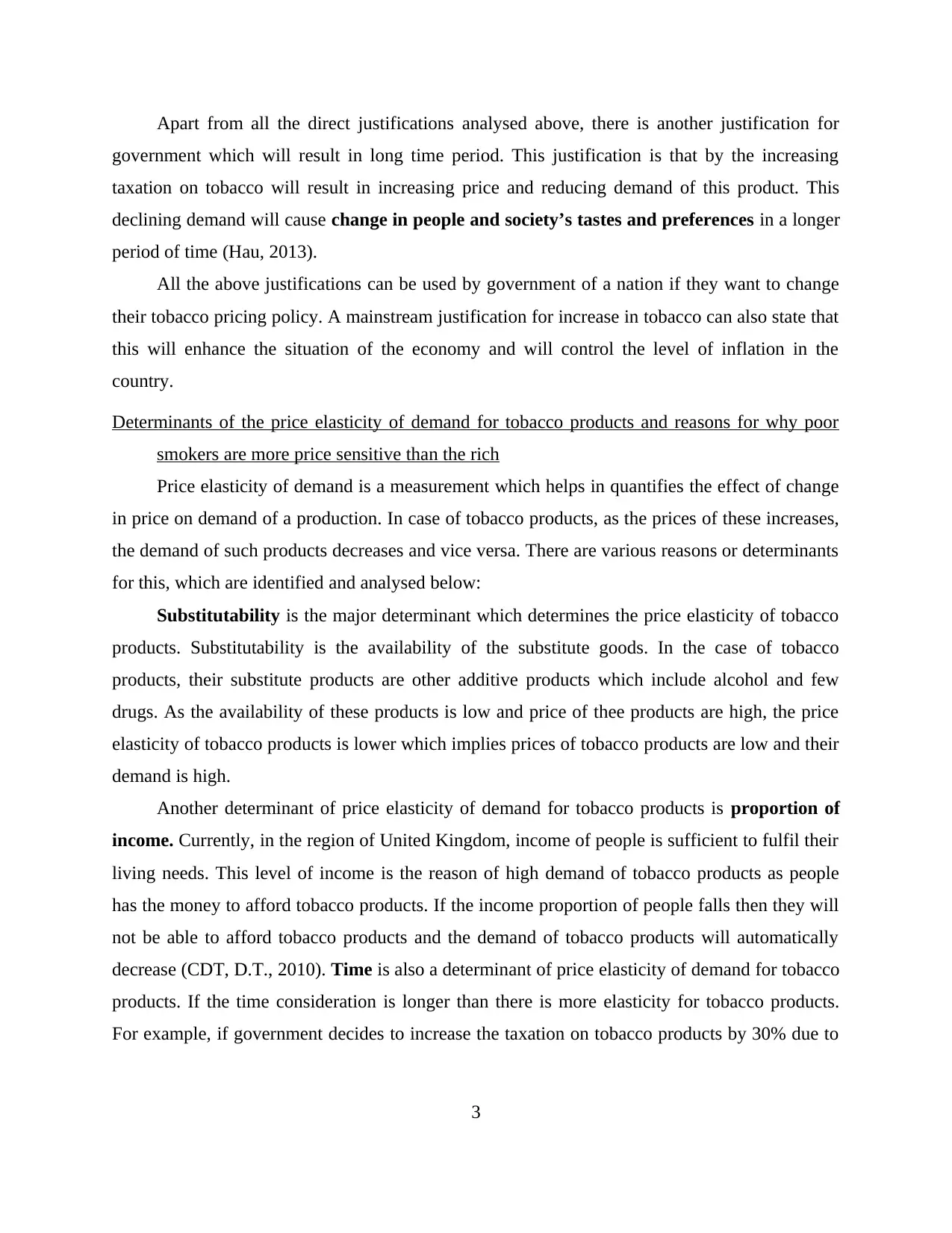
Apart from all the direct justifications analysed above, there is another justification for
government which will result in long time period. This justification is that by the increasing
taxation on tobacco will result in increasing price and reducing demand of this product. This
declining demand will cause change in people and society’s tastes and preferences in a longer
period of time (Hau, 2013).
All the above justifications can be used by government of a nation if they want to change
their tobacco pricing policy. A mainstream justification for increase in tobacco can also state that
this will enhance the situation of the economy and will control the level of inflation in the
country.
Determinants of the price elasticity of demand for tobacco products and reasons for why poor
smokers are more price sensitive than the rich
Price elasticity of demand is a measurement which helps in quantifies the effect of change
in price on demand of a production. In case of tobacco products, as the prices of these increases,
the demand of such products decreases and vice versa. There are various reasons or determinants
for this, which are identified and analysed below:
Substitutability is the major determinant which determines the price elasticity of tobacco
products. Substitutability is the availability of the substitute goods. In the case of tobacco
products, their substitute products are other additive products which include alcohol and few
drugs. As the availability of these products is low and price of thee products are high, the price
elasticity of tobacco products is lower which implies prices of tobacco products are low and their
demand is high.
Another determinant of price elasticity of demand for tobacco products is proportion of
income. Currently, in the region of United Kingdom, income of people is sufficient to fulfil their
living needs. This level of income is the reason of high demand of tobacco products as people
has the money to afford tobacco products. If the income proportion of people falls then they will
not be able to afford tobacco products and the demand of tobacco products will automatically
decrease (CDT, D.T., 2010). Time is also a determinant of price elasticity of demand for tobacco
products. If the time consideration is longer than there is more elasticity for tobacco products.
For example, if government decides to increase the taxation on tobacco products by 30% due to
3
government which will result in long time period. This justification is that by the increasing
taxation on tobacco will result in increasing price and reducing demand of this product. This
declining demand will cause change in people and society’s tastes and preferences in a longer
period of time (Hau, 2013).
All the above justifications can be used by government of a nation if they want to change
their tobacco pricing policy. A mainstream justification for increase in tobacco can also state that
this will enhance the situation of the economy and will control the level of inflation in the
country.
Determinants of the price elasticity of demand for tobacco products and reasons for why poor
smokers are more price sensitive than the rich
Price elasticity of demand is a measurement which helps in quantifies the effect of change
in price on demand of a production. In case of tobacco products, as the prices of these increases,
the demand of such products decreases and vice versa. There are various reasons or determinants
for this, which are identified and analysed below:
Substitutability is the major determinant which determines the price elasticity of tobacco
products. Substitutability is the availability of the substitute goods. In the case of tobacco
products, their substitute products are other additive products which include alcohol and few
drugs. As the availability of these products is low and price of thee products are high, the price
elasticity of tobacco products is lower which implies prices of tobacco products are low and their
demand is high.
Another determinant of price elasticity of demand for tobacco products is proportion of
income. Currently, in the region of United Kingdom, income of people is sufficient to fulfil their
living needs. This level of income is the reason of high demand of tobacco products as people
has the money to afford tobacco products. If the income proportion of people falls then they will
not be able to afford tobacco products and the demand of tobacco products will automatically
decrease (CDT, D.T., 2010). Time is also a determinant of price elasticity of demand for tobacco
products. If the time consideration is longer than there is more elasticity for tobacco products.
For example, if government decides to increase the taxation on tobacco products by 30% due to
3
⊘ This is a preview!⊘
Do you want full access?
Subscribe today to unlock all pages.

Trusted by 1+ million students worldwide
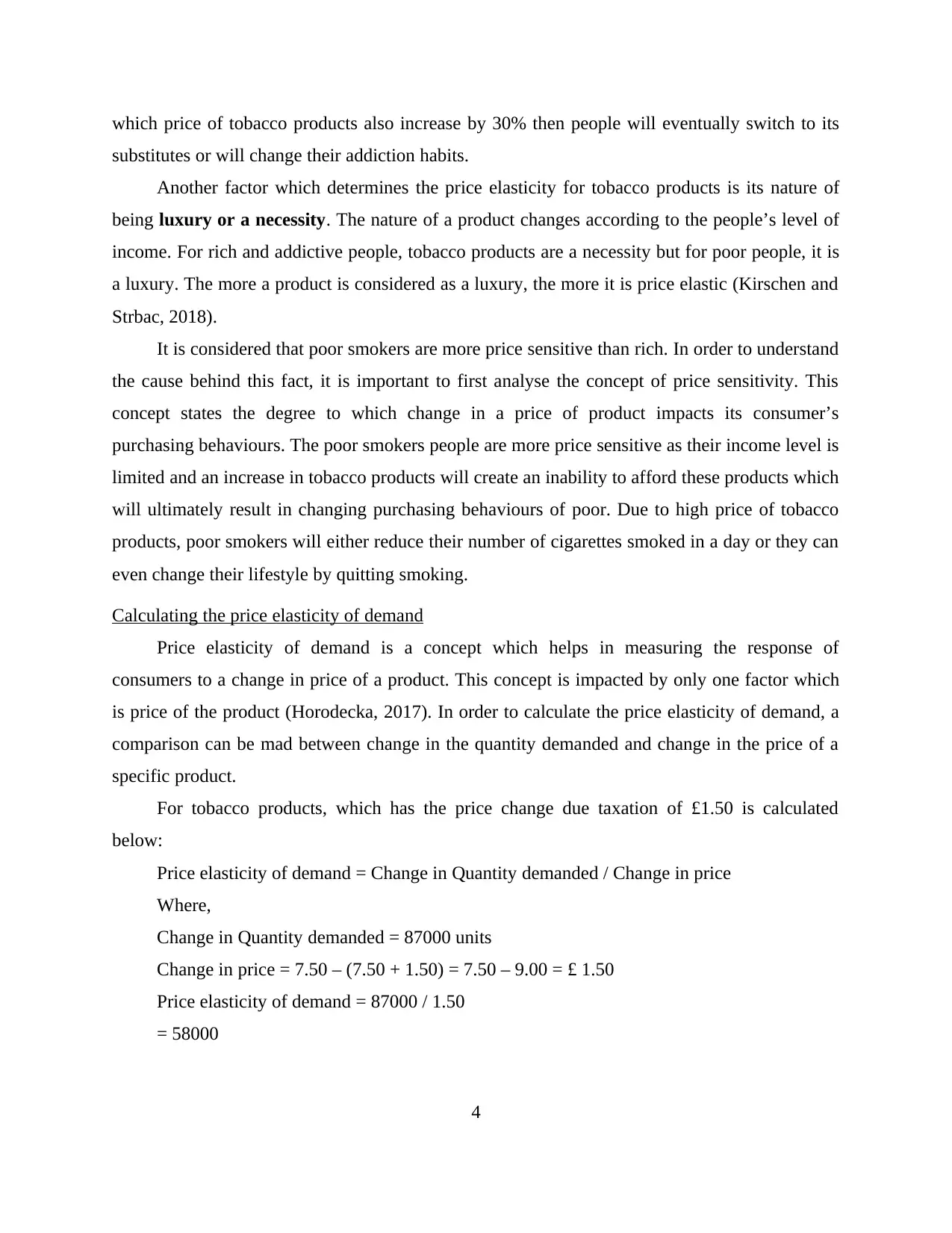
which price of tobacco products also increase by 30% then people will eventually switch to its
substitutes or will change their addiction habits.
Another factor which determines the price elasticity for tobacco products is its nature of
being luxury or a necessity. The nature of a product changes according to the people’s level of
income. For rich and addictive people, tobacco products are a necessity but for poor people, it is
a luxury. The more a product is considered as a luxury, the more it is price elastic (Kirschen and
Strbac, 2018).
It is considered that poor smokers are more price sensitive than rich. In order to understand
the cause behind this fact, it is important to first analyse the concept of price sensitivity. This
concept states the degree to which change in a price of product impacts its consumer’s
purchasing behaviours. The poor smokers people are more price sensitive as their income level is
limited and an increase in tobacco products will create an inability to afford these products which
will ultimately result in changing purchasing behaviours of poor. Due to high price of tobacco
products, poor smokers will either reduce their number of cigarettes smoked in a day or they can
even change their lifestyle by quitting smoking.
Calculating the price elasticity of demand
Price elasticity of demand is a concept which helps in measuring the response of
consumers to a change in price of a product. This concept is impacted by only one factor which
is price of the product (Horodecka, 2017). In order to calculate the price elasticity of demand, a
comparison can be mad between change in the quantity demanded and change in the price of a
specific product.
For tobacco products, which has the price change due taxation of £1.50 is calculated
below:
Price elasticity of demand = Change in Quantity demanded / Change in price
Where,
Change in Quantity demanded = 87000 units
Change in price = 7.50 – (7.50 + 1.50) = 7.50 – 9.00 = £ 1.50
Price elasticity of demand = 87000 / 1.50
= 58000
4
substitutes or will change their addiction habits.
Another factor which determines the price elasticity for tobacco products is its nature of
being luxury or a necessity. The nature of a product changes according to the people’s level of
income. For rich and addictive people, tobacco products are a necessity but for poor people, it is
a luxury. The more a product is considered as a luxury, the more it is price elastic (Kirschen and
Strbac, 2018).
It is considered that poor smokers are more price sensitive than rich. In order to understand
the cause behind this fact, it is important to first analyse the concept of price sensitivity. This
concept states the degree to which change in a price of product impacts its consumer’s
purchasing behaviours. The poor smokers people are more price sensitive as their income level is
limited and an increase in tobacco products will create an inability to afford these products which
will ultimately result in changing purchasing behaviours of poor. Due to high price of tobacco
products, poor smokers will either reduce their number of cigarettes smoked in a day or they can
even change their lifestyle by quitting smoking.
Calculating the price elasticity of demand
Price elasticity of demand is a concept which helps in measuring the response of
consumers to a change in price of a product. This concept is impacted by only one factor which
is price of the product (Horodecka, 2017). In order to calculate the price elasticity of demand, a
comparison can be mad between change in the quantity demanded and change in the price of a
specific product.
For tobacco products, which has the price change due taxation of £1.50 is calculated
below:
Price elasticity of demand = Change in Quantity demanded / Change in price
Where,
Change in Quantity demanded = 87000 units
Change in price = 7.50 – (7.50 + 1.50) = 7.50 – 9.00 = £ 1.50
Price elasticity of demand = 87000 / 1.50
= 58000
4
Paraphrase This Document
Need a fresh take? Get an instant paraphrase of this document with our AI Paraphraser
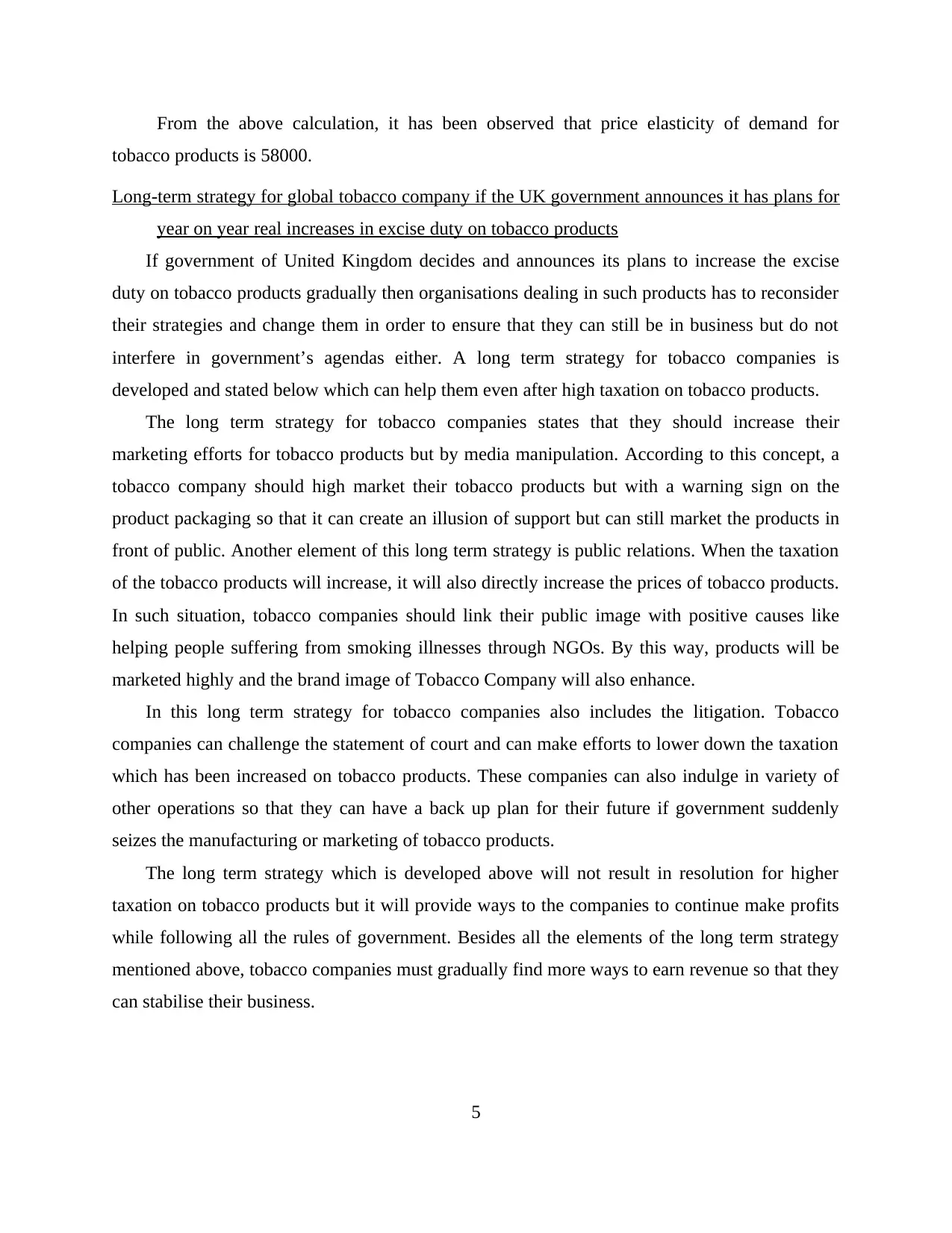
From the above calculation, it has been observed that price elasticity of demand for
tobacco products is 58000.
Long-term strategy for global tobacco company if the UK government announces it has plans for
year on year real increases in excise duty on tobacco products
If government of United Kingdom decides and announces its plans to increase the excise
duty on tobacco products gradually then organisations dealing in such products has to reconsider
their strategies and change them in order to ensure that they can still be in business but do not
interfere in government’s agendas either. A long term strategy for tobacco companies is
developed and stated below which can help them even after high taxation on tobacco products.
The long term strategy for tobacco companies states that they should increase their
marketing efforts for tobacco products but by media manipulation. According to this concept, a
tobacco company should high market their tobacco products but with a warning sign on the
product packaging so that it can create an illusion of support but can still market the products in
front of public. Another element of this long term strategy is public relations. When the taxation
of the tobacco products will increase, it will also directly increase the prices of tobacco products.
In such situation, tobacco companies should link their public image with positive causes like
helping people suffering from smoking illnesses through NGOs. By this way, products will be
marketed highly and the brand image of Tobacco Company will also enhance.
In this long term strategy for tobacco companies also includes the litigation. Tobacco
companies can challenge the statement of court and can make efforts to lower down the taxation
which has been increased on tobacco products. These companies can also indulge in variety of
other operations so that they can have a back up plan for their future if government suddenly
seizes the manufacturing or marketing of tobacco products.
The long term strategy which is developed above will not result in resolution for higher
taxation on tobacco products but it will provide ways to the companies to continue make profits
while following all the rules of government. Besides all the elements of the long term strategy
mentioned above, tobacco companies must gradually find more ways to earn revenue so that they
can stabilise their business.
5
tobacco products is 58000.
Long-term strategy for global tobacco company if the UK government announces it has plans for
year on year real increases in excise duty on tobacco products
If government of United Kingdom decides and announces its plans to increase the excise
duty on tobacco products gradually then organisations dealing in such products has to reconsider
their strategies and change them in order to ensure that they can still be in business but do not
interfere in government’s agendas either. A long term strategy for tobacco companies is
developed and stated below which can help them even after high taxation on tobacco products.
The long term strategy for tobacco companies states that they should increase their
marketing efforts for tobacco products but by media manipulation. According to this concept, a
tobacco company should high market their tobacco products but with a warning sign on the
product packaging so that it can create an illusion of support but can still market the products in
front of public. Another element of this long term strategy is public relations. When the taxation
of the tobacco products will increase, it will also directly increase the prices of tobacco products.
In such situation, tobacco companies should link their public image with positive causes like
helping people suffering from smoking illnesses through NGOs. By this way, products will be
marketed highly and the brand image of Tobacco Company will also enhance.
In this long term strategy for tobacco companies also includes the litigation. Tobacco
companies can challenge the statement of court and can make efforts to lower down the taxation
which has been increased on tobacco products. These companies can also indulge in variety of
other operations so that they can have a back up plan for their future if government suddenly
seizes the manufacturing or marketing of tobacco products.
The long term strategy which is developed above will not result in resolution for higher
taxation on tobacco products but it will provide ways to the companies to continue make profits
while following all the rules of government. Besides all the elements of the long term strategy
mentioned above, tobacco companies must gradually find more ways to earn revenue so that they
can stabilise their business.
5
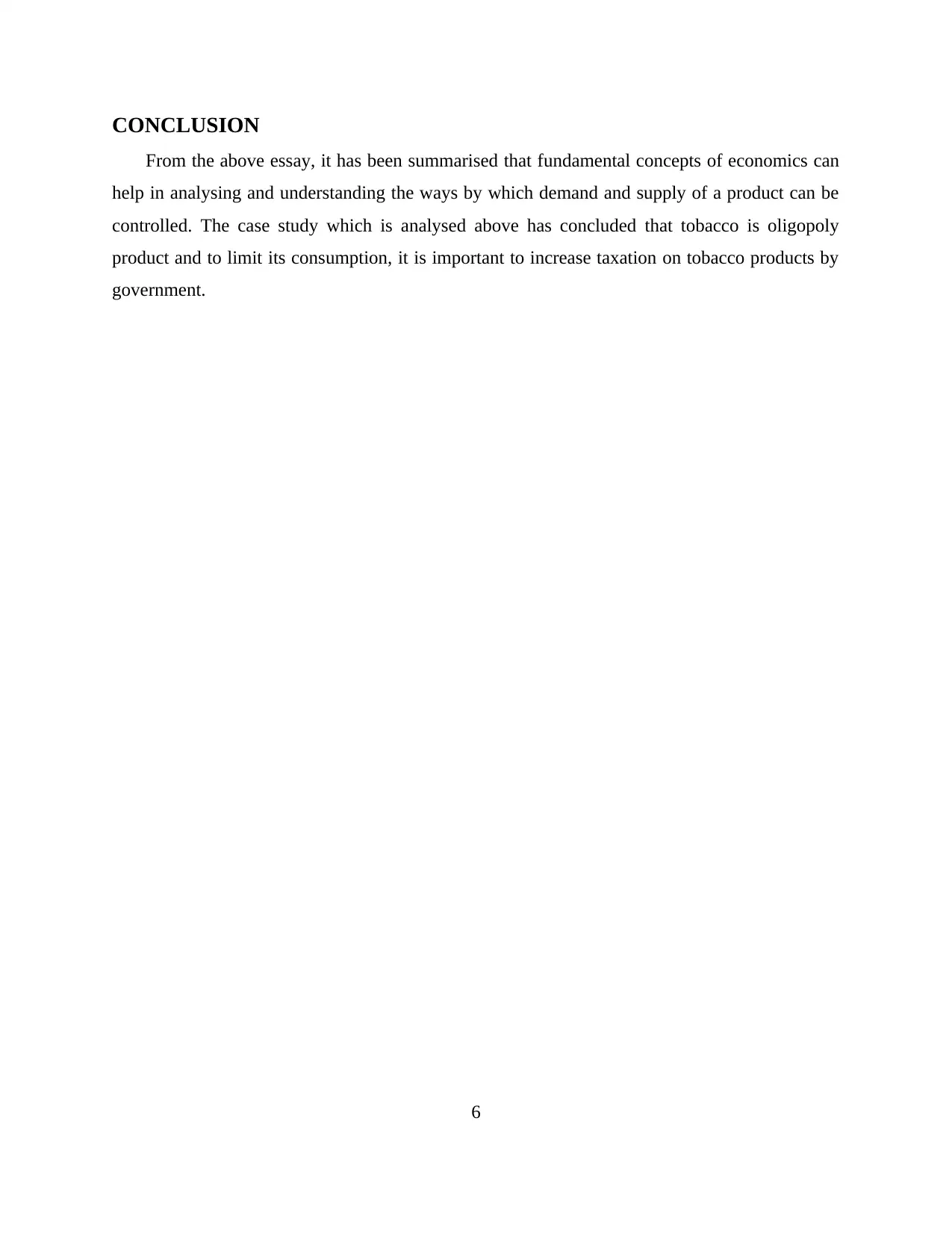
CONCLUSION
From the above essay, it has been summarised that fundamental concepts of economics can
help in analysing and understanding the ways by which demand and supply of a product can be
controlled. The case study which is analysed above has concluded that tobacco is oligopoly
product and to limit its consumption, it is important to increase taxation on tobacco products by
government.
6
From the above essay, it has been summarised that fundamental concepts of economics can
help in analysing and understanding the ways by which demand and supply of a product can be
controlled. The case study which is analysed above has concluded that tobacco is oligopoly
product and to limit its consumption, it is important to increase taxation on tobacco products by
government.
6
⊘ This is a preview!⊘
Do you want full access?
Subscribe today to unlock all pages.

Trusted by 1+ million students worldwide
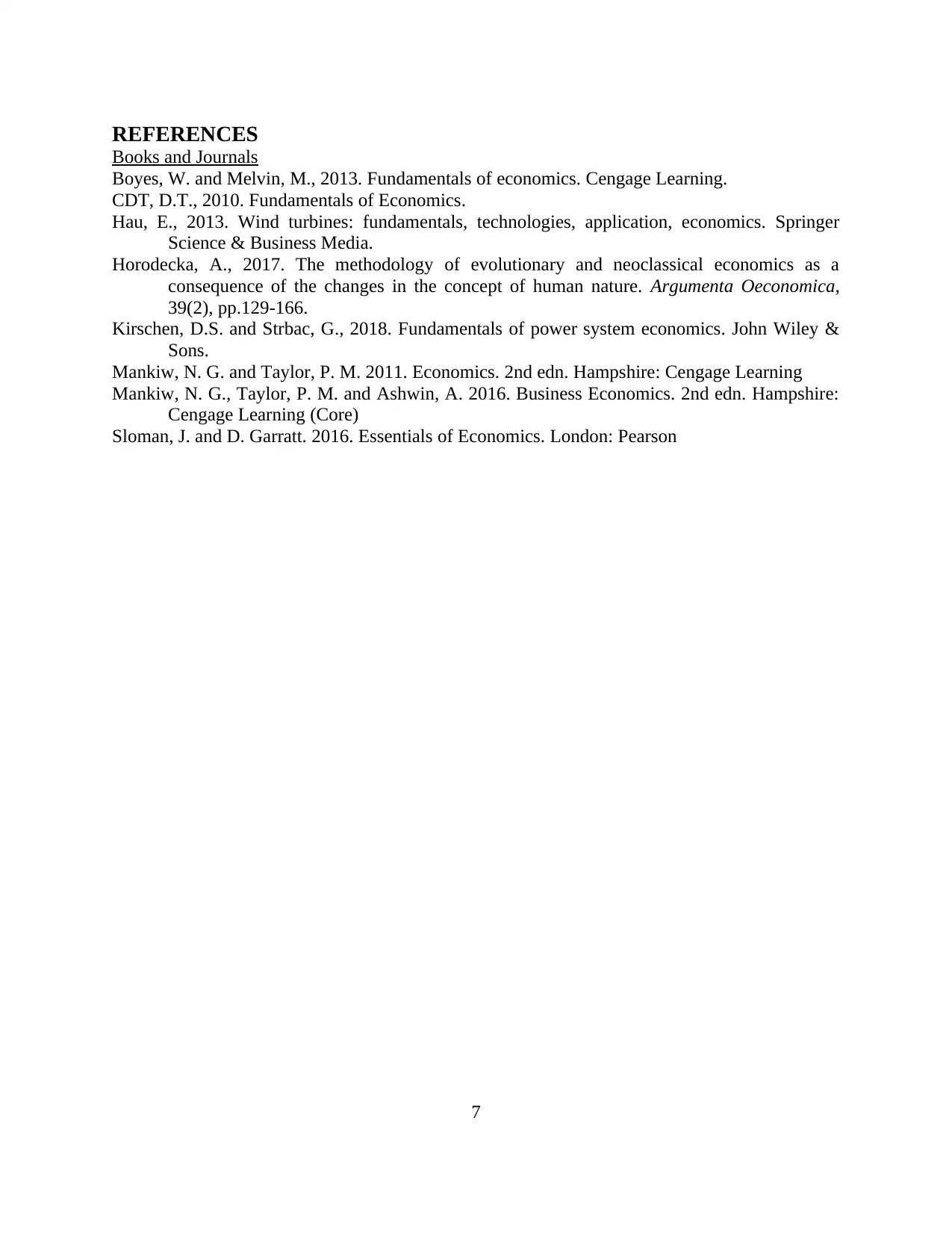
REFERENCES
Books and Journals
Boyes, W. and Melvin, M., 2013. Fundamentals of economics. Cengage Learning.
CDT, D.T., 2010. Fundamentals of Economics.
Hau, E., 2013. Wind turbines: fundamentals, technologies, application, economics. Springer
Science & Business Media.
Horodecka, A., 2017. The methodology of evolutionary and neoclassical economics as a
consequence of the changes in the concept of human nature. Argumenta Oeconomica,
39(2), pp.129-166.
Kirschen, D.S. and Strbac, G., 2018. Fundamentals of power system economics. John Wiley &
Sons.
Mankiw, N. G. and Taylor, P. M. 2011. Economics. 2nd edn. Hampshire: Cengage Learning
Mankiw, N. G., Taylor, P. M. and Ashwin, A. 2016. Business Economics. 2nd edn. Hampshire:
Cengage Learning (Core)
Sloman, J. and D. Garratt. 2016. Essentials of Economics. London: Pearson
7
Books and Journals
Boyes, W. and Melvin, M., 2013. Fundamentals of economics. Cengage Learning.
CDT, D.T., 2010. Fundamentals of Economics.
Hau, E., 2013. Wind turbines: fundamentals, technologies, application, economics. Springer
Science & Business Media.
Horodecka, A., 2017. The methodology of evolutionary and neoclassical economics as a
consequence of the changes in the concept of human nature. Argumenta Oeconomica,
39(2), pp.129-166.
Kirschen, D.S. and Strbac, G., 2018. Fundamentals of power system economics. John Wiley &
Sons.
Mankiw, N. G. and Taylor, P. M. 2011. Economics. 2nd edn. Hampshire: Cengage Learning
Mankiw, N. G., Taylor, P. M. and Ashwin, A. 2016. Business Economics. 2nd edn. Hampshire:
Cengage Learning (Core)
Sloman, J. and D. Garratt. 2016. Essentials of Economics. London: Pearson
7
1 out of 10
Related Documents
Your All-in-One AI-Powered Toolkit for Academic Success.
+13062052269
info@desklib.com
Available 24*7 on WhatsApp / Email
![[object Object]](/_next/static/media/star-bottom.7253800d.svg)
Unlock your academic potential
Copyright © 2020–2025 A2Z Services. All Rights Reserved. Developed and managed by ZUCOL.





